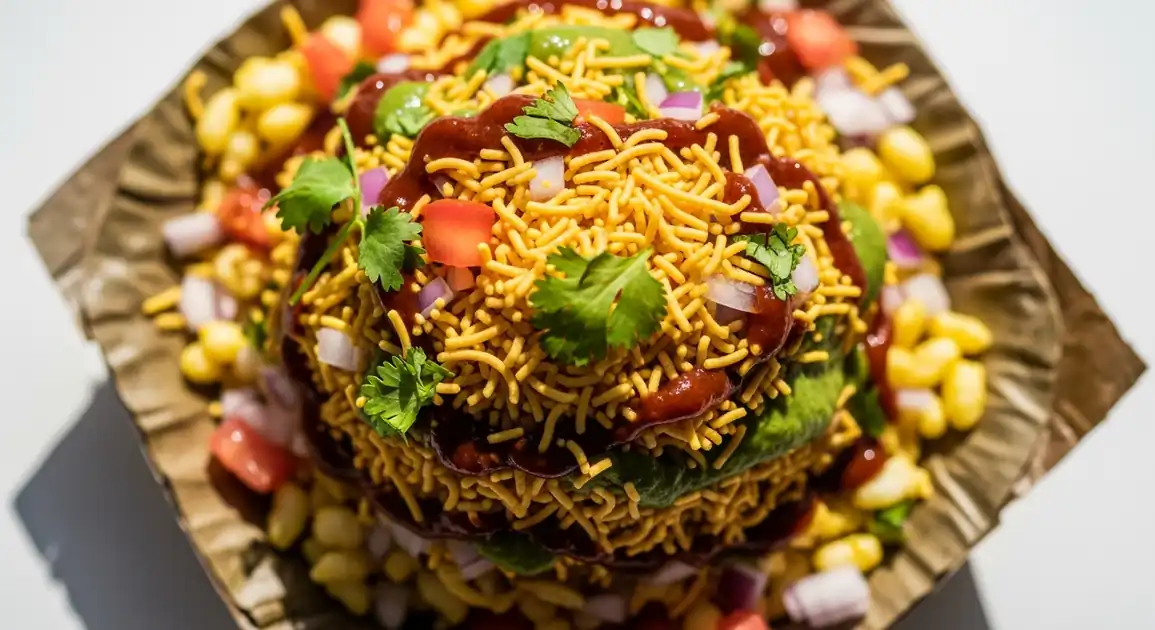Bhel Puri
भेल पूरी

Description
Mumbai is the undisputed home of bhel puri, where it was perfected on the city's famous beaches. Here, bhel puri is an institution with decades-old vendors drawing crowds for their perfect balance of flavors. The Mumbai style – characterized by its juicier consistency and tangy-sweet profile – sets the gold standard that other cities try to emulate. From upscale versions in restaurants to classic beach stalls, Mumbai offers the full spectrum of bhel puri experiences.
Dietary Information
Serving information
Serving style
In Mumbai, traditionally served in a paper cone or dona (leaf cup) at beaches, or on small paper plates elsewhere. Eaten with small wooden spoons or folded paper spoons.
Quick facts
Beach vendors: 12 PM - 10 PM (peak 4 PM - 9 PM); City center vendors: 11 AM - 8 PM (peak during lunch and after work hours).
Safety Tips
What to Look For
-
Fresh, covered ingredients in clean containers
Ingredients should be stored in covered containers to protect from flies, dust, and pollution. Vegetables should look freshly cut and vibrant.
-
Individual mixing for each customer
The vendor should prepare each serving individually upon order, not pre-mix and serve from a ready batch, which can become soggy and collect bacteria.
-
High customer turnover
Popular vendors have frequent customers, ensuring ingredients don't sit out long and are replenished regularly.
-
Clean, organized workstation
The preparation area should be tidy with separate utensils for different ingredients and visible efforts to maintain cleanliness.
-
Freshly made, properly stored chutneys
Chutneys should look freshly made, not oxidized or fermented, and kept in clean, covered containers.
What to avoid
-
Pre-mixed bhel sitting in large batches
Avoid vendors who pre-mix bhel and let it sit, as this allows bacterial growth and results in soggy texture.
-
Uncovered ingredients exposed to flies/dust
Ingredients left open to the environment collect contaminants, especially in busy street/beach settings.
-
Visibly dirty water used for chutneys or washing
Water quality is crucial as chutneys and sometimes ingredients are rinsed with water. Avoid if you notice questionable water sources.
-
Vendors handling money and food without washing
Cross-contamination from currency to food is a common issue. Look for vendors who have separate people handling money or who wash/sanitize between tasks.
-
Old, discolored vegetables or wilted herbs
These indicate poor inventory management and potentially unsafe food practices.
Price information
Price range
Budget tips
- Classic street vendors away from tourist areas charge 30-50 INR.
- Famous beach stalls at Juhu and Chowpatty charge 50-80 INR.
- Restaurant versions cost 80-120 INR but offer more hygienic preparation.
- Avoid extremely cheap options at around 20 INR as they likely use inferior ingredients.
- The train station area vendors often offer good value at 40-50 INR.
Value indicators
- Generous portion with ample chutneys
- Fresh, just-chopped vegetables
- Appropriate wetness (not too dry, not soggy)
- Crisp puffed rice and sev
- Perfect balance of sweet, tangy, and spicy notes
Where to Find This Dish
Juhu Beach
Home to some of Mumbai's most famous bhel puri stalls, with decades of history and loyal followings. The beachfront setting adds to the authentic experience.
Juhu Beach main entrance, Near Juhu Chowpatty
Evening (4 PM - 8 PM), Weekends
Chowpatty Beach
The original bhel puri hub with historic stalls. Girgaum Chowpatty vendors are institutions in Mumbai's food scene.
Girgaum Chowpatty, Marine Drive
Evening (5 PM - 9 PM), Weekends
Khau Galli (Food Streets)
Various food streets across Mumbai offer excellent bhel puri alongside other chaat items.
Carter Road food stalls, Mohammed Ali Road, Ghatkopar Khau Galli
Evening (6 PM - 10 PM)
Fort / CST Area
Business district vendors cater to office workers with quick, flavorful bhel puri during lunch hours and after work.
Near CST Station, Fort business district
Lunch (12 PM - 2 PM), After work (5 PM - 7 PM)
Vendor Tips
- At beaches, look for vendors with the longest lines of locals (not just tourists).
- Ask for 'balancing' all chutneys for the authentic Mumbai experience.
- Some famous vendors have their stalls named (like 'Sharma Bhel Puri' or 'Badshah Bhel') – these are often reliable choices.
- Vendors who constantly refresh their chopped ingredients typically serve fresher bhel.
How to Order
Regional Variations
-
Juhu Beach Style
(जुहू बीच स्टाइल)
Known for being slightly wetter with more tamarind chutney and finely chopped ingredients.
-
Bombay Bhel
(बॉम्बे भेल)
The classic style with perfect balance of wet and dry ingredients, often with a sprinkle of chaat masala on top.
-
Sukha (Dry) Mumbai Bhel
(सूखा मुंबई भेल)
A variation with minimal chutney, popular for takeaway when you can't eat immediately.
-
Mumbai Chinese Bhel
(मुंबई चाइनीज भेल)
A unique Mumbai fusion using fried noodles instead of puffed rice, with schezwan sauce – found in street-side 'Chinese' stalls throughout the city.
Cultural context
History
Originating from the beach stalls of Mumbai (formerly Bombay) in the 1970s, Bhel Puri evolved from simple beach snacks into a national street food sensation. Its roots trace back to Gujarat's dry 'chidwa' snack mix, combined with Maharashtra's love for complex chutneys. Initially popular at Juhu and Chowpatty beaches where vendors created the perfect mix to enjoy while watching waves, it captured the city's diverse cultural influences and became emblematic of Mumbai's fast-paced street food culture, eventually spreading throughout India.
Local significance
In Mumbai, bhel puri is more than food – it's a cultural icon representing the city's fast-paced, vibrant character. It embodies Mumbai's ability to blend diverse influences into something uniquely its own, much like the city itself.
Eating customs
- Mumbaikars often specify their preferred wetness level (sukha or geela/wet).
- The 'Mumbai style' typically includes more tamarind chutney than other cities' versions.
- Locals know to eat it immediately before it becomes soggy.